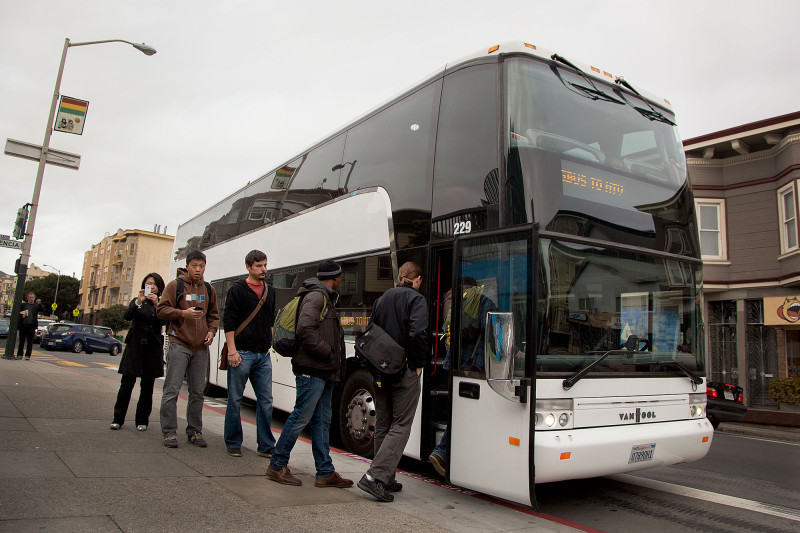However, the study says that the shuttles, typically large motor coaches that carry 40 or more passengers, still have a way of obstructing the streets. The SFMTA spot check found the big buses blocked other traffic -- either other motor vehicles or bicycles -- on about 35 percent of their stops.
At the worst locations -- Valencia and 24th streets, 16th and Mission streets, Lombard and Pierce streets, and Divisadero Street and Geary Boulevard, for instance -- private shuttle buses block other traffic virtually every time they stop to take on or discharge passengers.
The study suggests that tougher traffic enforcement is needed to ensure shuttles don't double park and to ensure they avoid unauthorized use of Muni bus stops. In the first 10 months of the pilot, the report says, the SFMTA issued 1,200 citations to shuttle buses for those two offenses.
"Double-parking is dangerous for everyone who walks, bikes and drives, resulting in unpredictable behavior by people trying to get around double-parked vehicles," said Chris Cassidy, communications director for the San Francisco Bike Coalition.
The report also includes results of an SFMTA survey that included responses from 550 shuttle riders. Nearly half of those respondents said they'd drive alone in their cars if the shuttles weren't available. Based on that response, the SFMTA estimates the shuttles eliminate about 4.3 million vehicle miles traveled from the region's streets and highways.
"The pilot program took cars off the road and created a situation where the shuttles could operate safely, as opposed to the kind of unregulated Wild West conditions that were out there before," said Tom Maguire, director of SFMTA's Sustainable Streets program, which produced the report.
The pilot project is scheduled to run through the end of January 2016. Business groups support making the program permanent, but whether it becomes a fixture on city streets may depend on the outcome of a lawsuit filed last year by anti-eviction activists who say the private shuttle buses have fueled a rising tide of displacement in the city.
The lawsuit seeks to require the city to review the pilot project under the California Environmental Quality Act, a review that must include an assessment of the project's impact on pedestrian and bicyclist safety, on air quality and on its "potential to displace low- and moderate-income individuals."
Shuttle opponents told the San Francisco Chronicle:
“We’ve been pretty upset that the SFMTA, in evaluating the program, has not looked at the impacts on housing that the stops are having,” said Erin McElroy, of the Anti-Eviction Mapping Project. “We’ve found that rents have risen dramatically in the areas where stops are located, and so have evictions.”
Cynthia Crews, a self-described “transit geek,” is part of a group that has sued the city, seeking an environmental impact report on the shuttle program. But she doesn’t want to stop there. The city should also investigate the wear and tear shuttles are inflicting on the city’s roads and Muni’s bus stops as well as the effects on housing, she said.
“All of these things should be studied, then from that, they could legally assess a fee,” she said. “We just feel they’re not paying their fair share.”
KQED's Amanda Font contributed to this post.
